Abstract
A 10 mM concentration of Zn2+ decreased the survival of Escherichia coli; enhanced the survival of Bacillus cereus; did not significantly affect the survival of Pseudomonas aeruginosa, Norcardia corallina, and T1, T7, P1, and phi80 coliphages; completely inhibited mycelial growth of Rhizoctonia solani; and reduced mycelial growth of Fusarium solani, Cunninghamella echinulata, Aspergillus niger, and Trichoderma viride. The toxicity of zinc to the fungi, bacteria, and coliphages was unaffected, lessened, or increased by the addition of high concentrations of NaCl. The increased toxicity of zinc in the presence of high concentrations of NaCl was not a result of a synergistic interaction between Zn2+ and elevated osmotic pressures but of the formation of complex anionic ZnCl species that exerted greater toxicities than did cationic Zn2+. Conversely, the decrease in zinc toxicity with increasing concentrations of NaCl probably reflected the decrease in the levels of Zn2+ due to the formation of Zn-Cl species, which was less inhibitory to these microbes than was Zn2+. A. niger tolerated higher concentrations of zinc in the presence of NaCl at 37 than at 25 degrees C.
Full text
PDF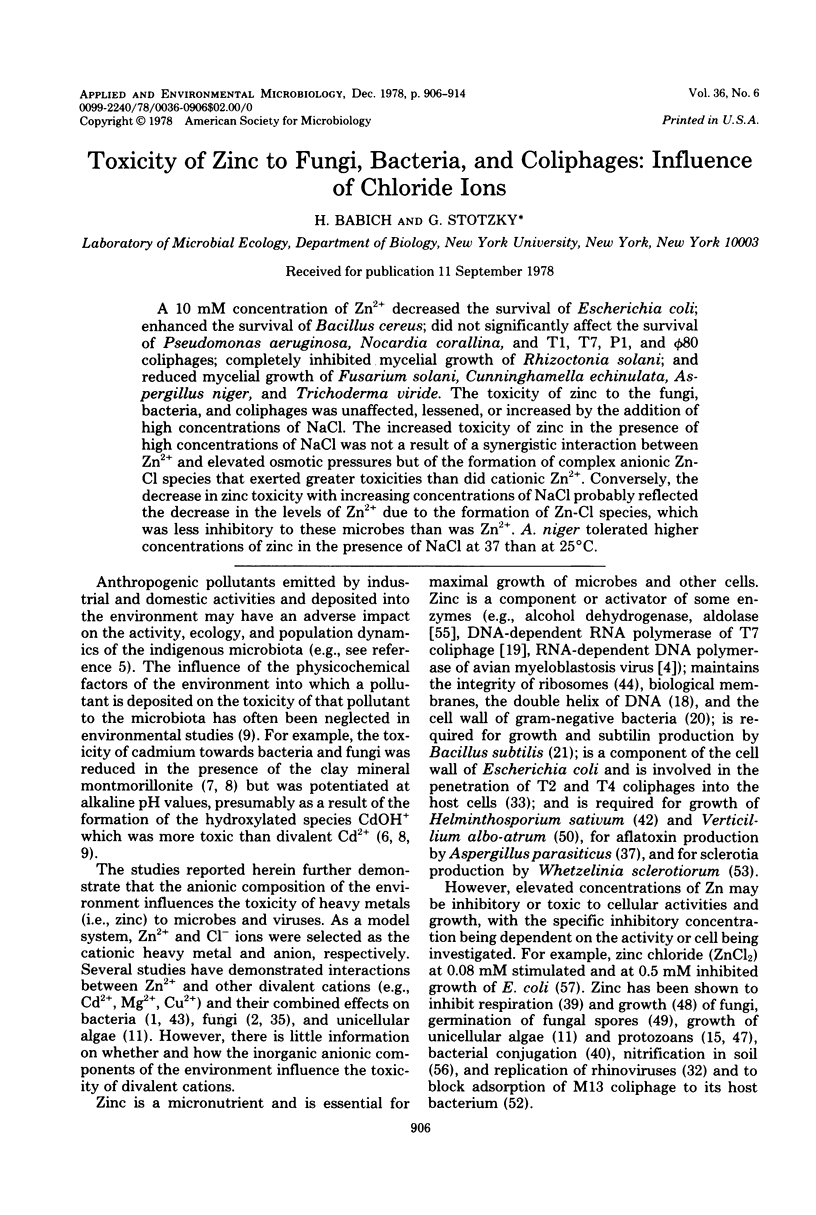
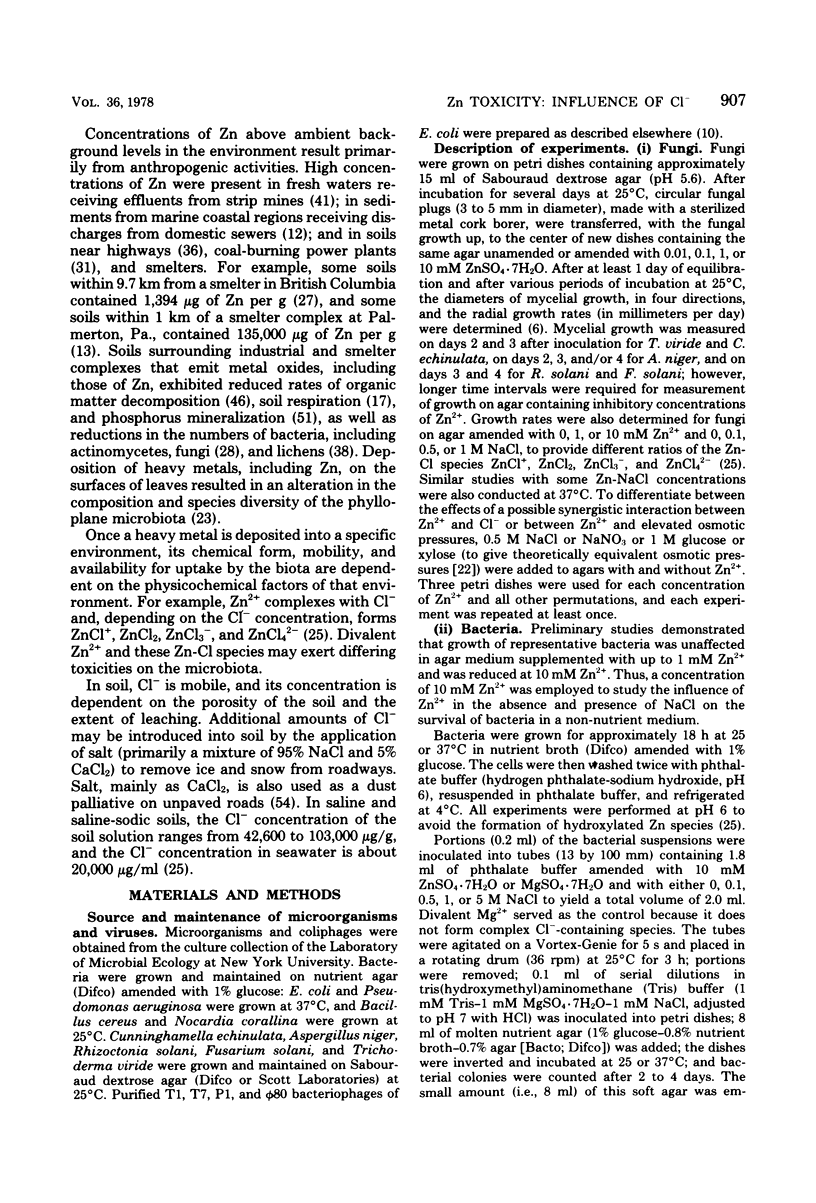
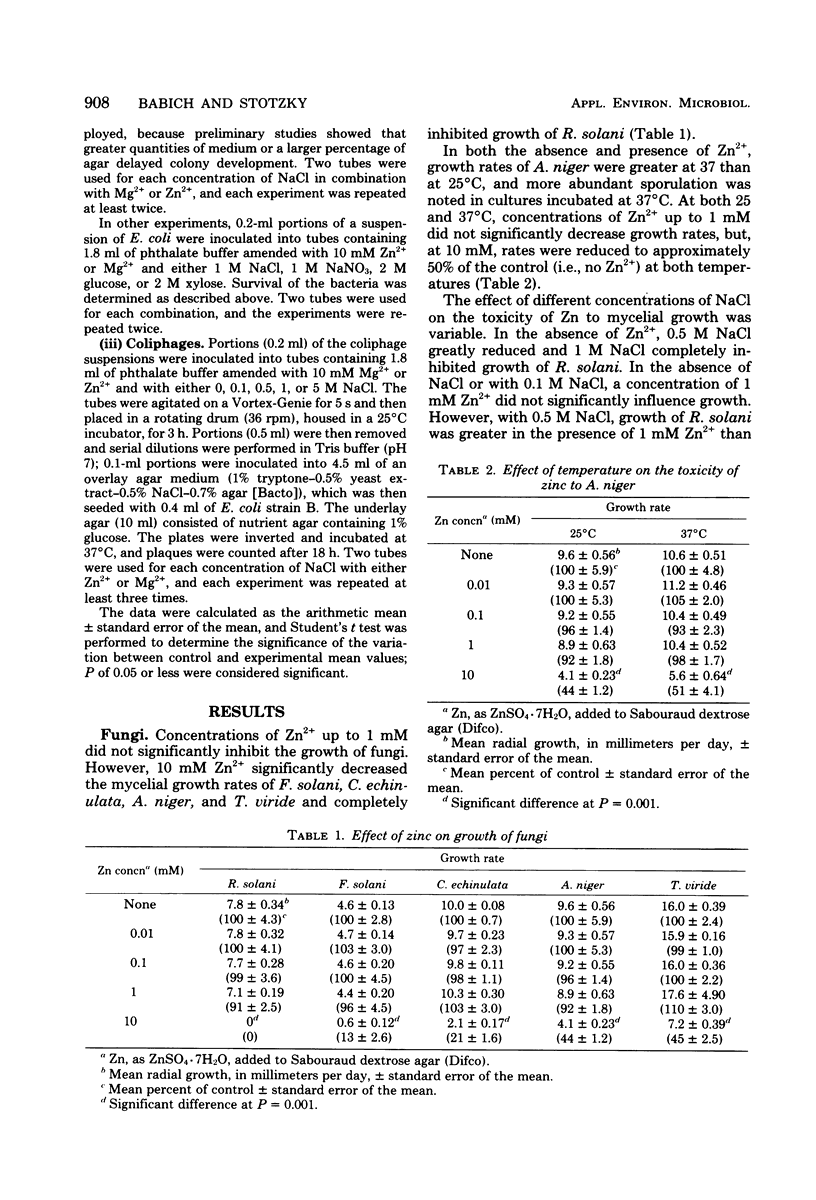

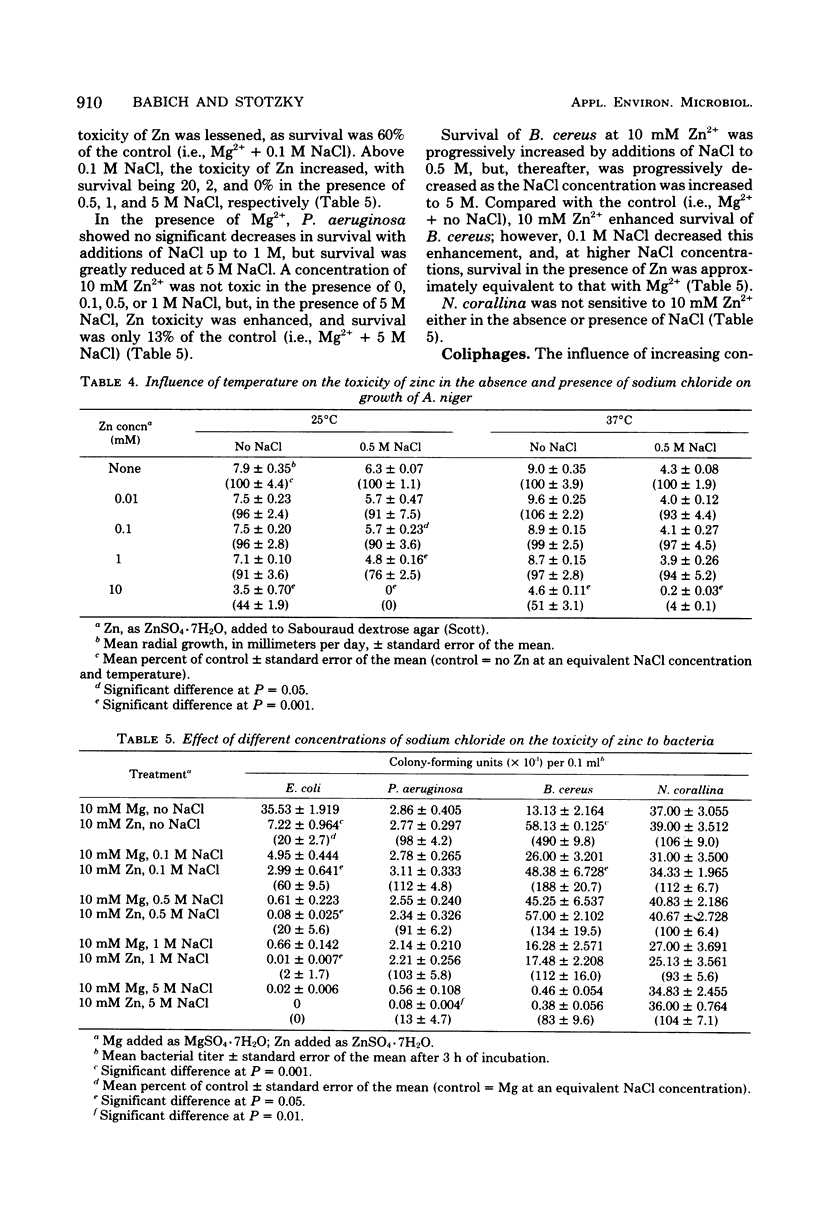
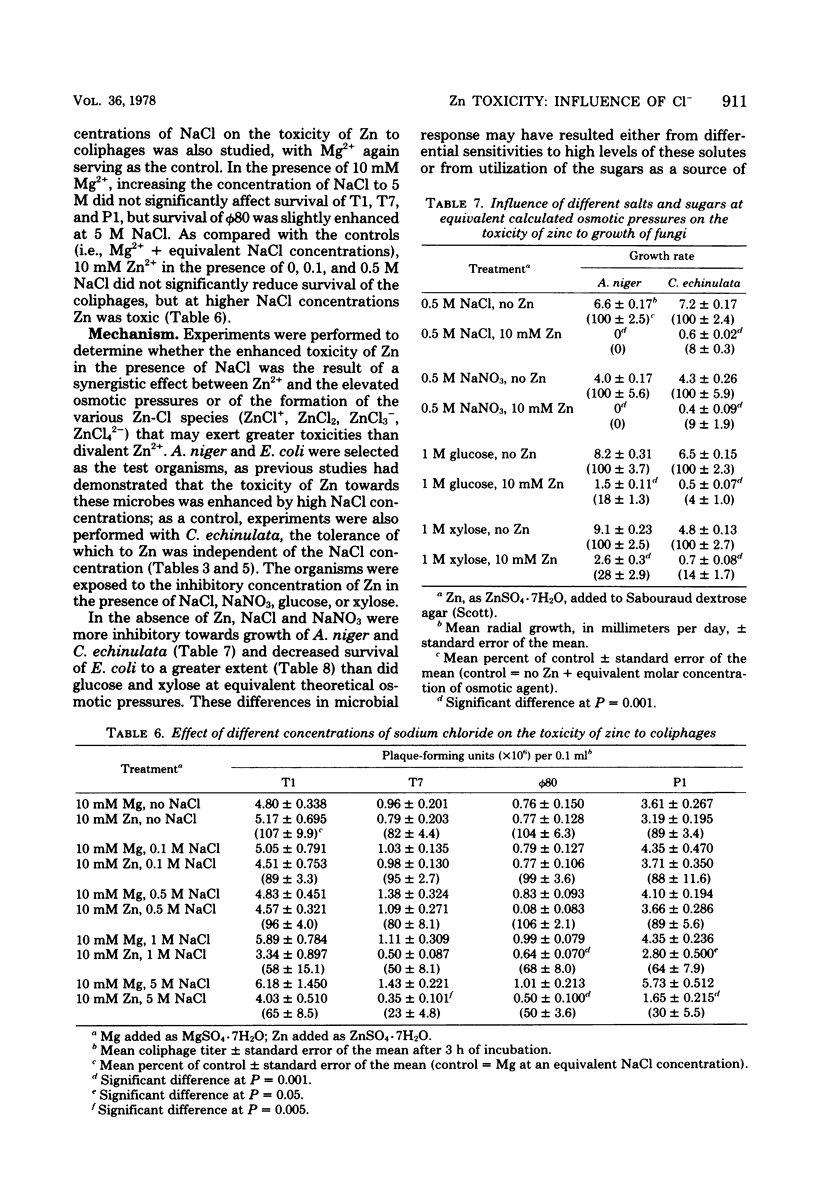
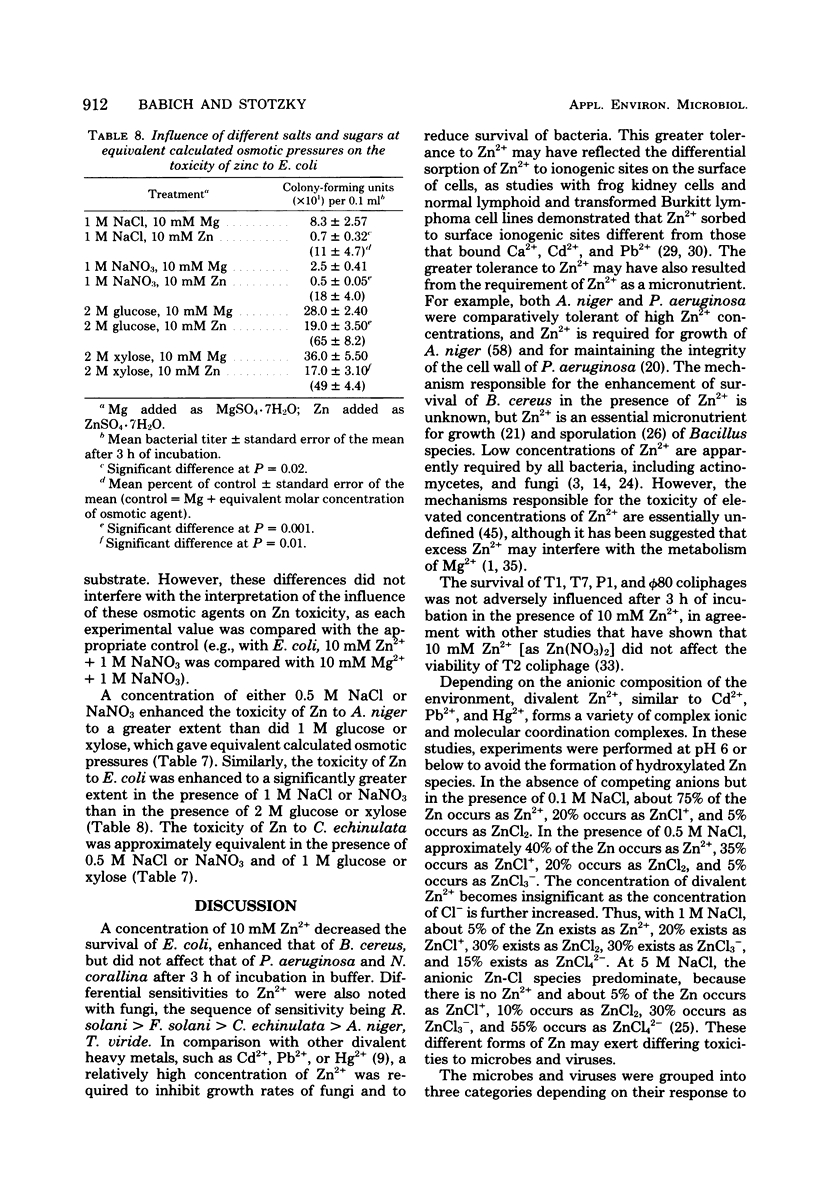
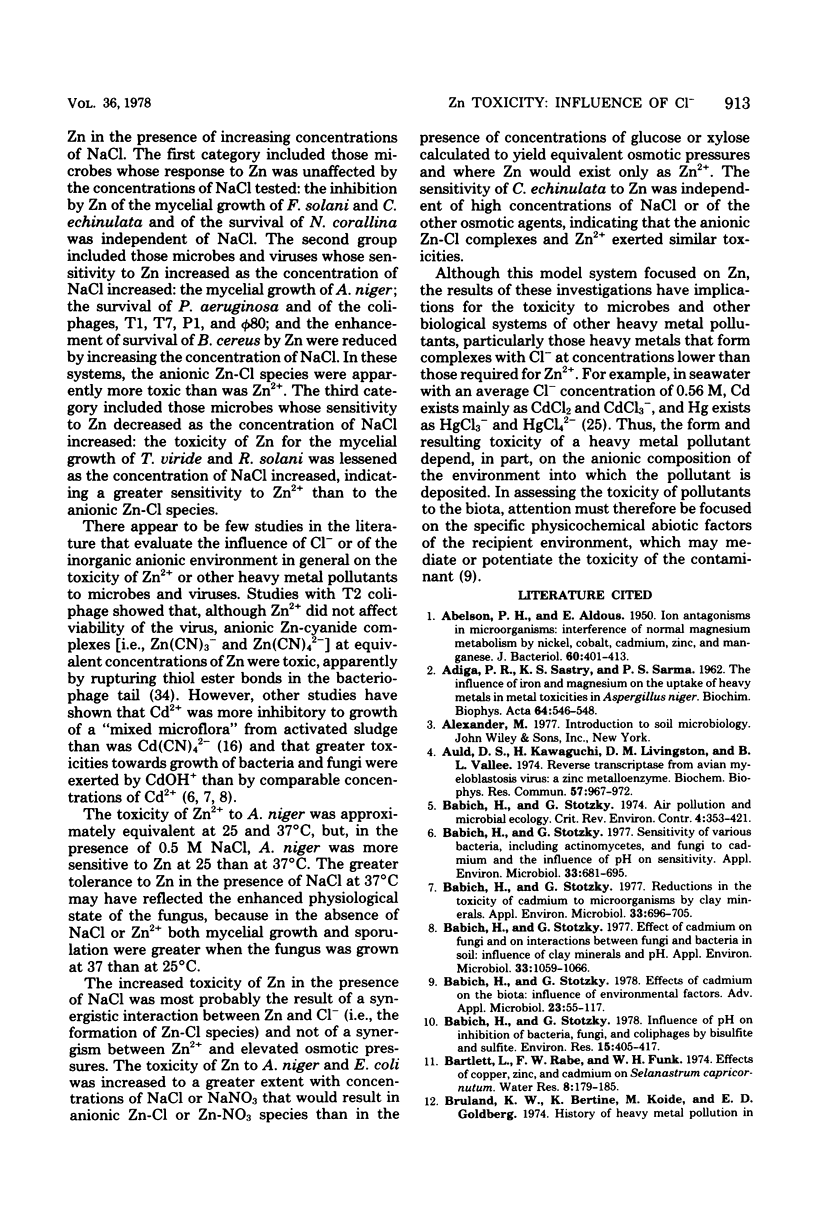
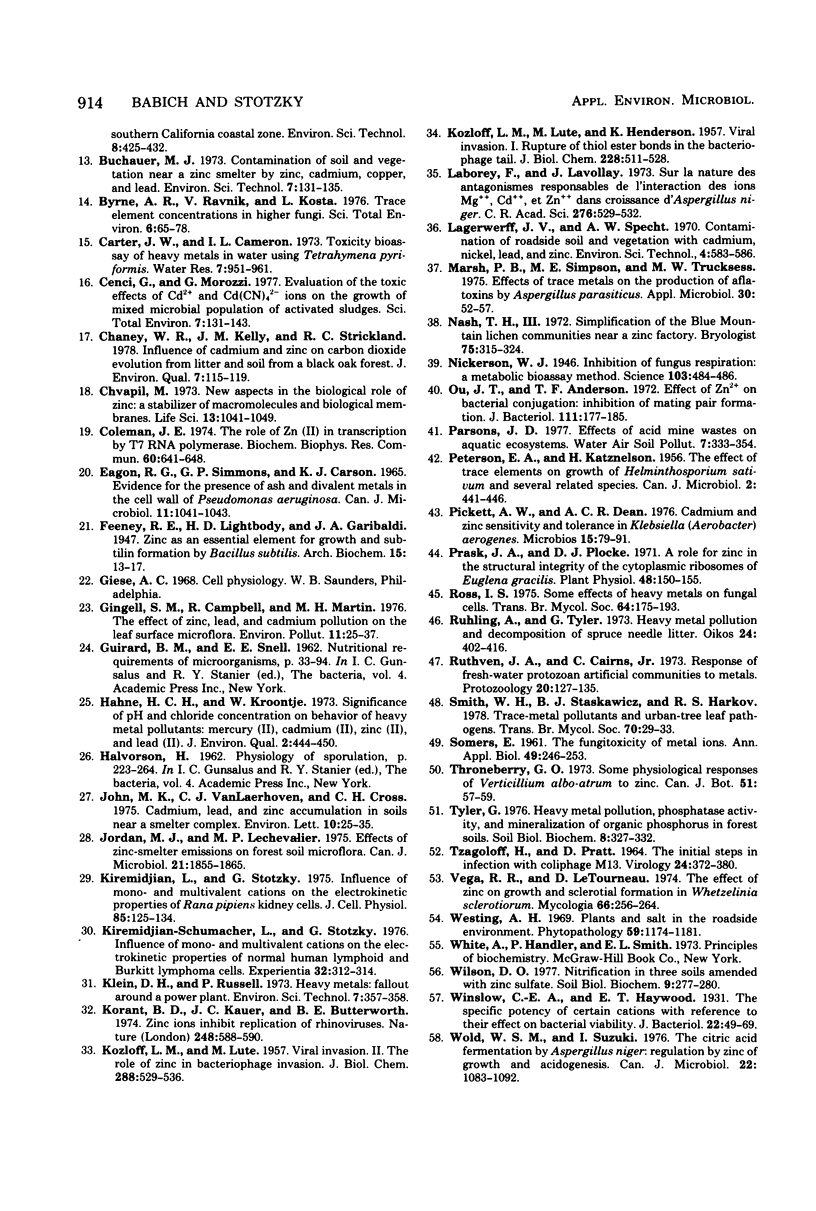
Selected References
These references are in PubMed. This may not be the complete list of references from this article.
- ABELSON P. H., ALDOUS E. Ion antagonisms in microorganisms; interference of normal magnesium metabolism by nickel, cobalt, cadmium, zinc, and manganese. J Bacteriol. 1950 Oct;60(4):401–413. doi: 10.1128/jb.60.4.401-413.1950. [DOI] [PMC free article] [PubMed] [Google Scholar]
- ADIGA P. R., SIVARAMA SASTRY K., SARMA P. S. The influence of iron and magnesium on the uptake of heavy metals in metal toxicities in Aspergillus niger. Biochim Biophys Acta. 1962 Nov 5;64:546–548. doi: 10.1016/0006-3002(62)90313-x. [DOI] [PubMed] [Google Scholar]
- Auld D. S., Kawaguchi H., Livingston D. M., Vallee B. L. Reverse transcriptase from avian myeloblastosis virus: a zinc metalloenzyme. Biochem Biophys Res Commun. 1974 Apr 23;57(4):967–972. doi: 10.1016/0006-291x(74)90790-6. [DOI] [PubMed] [Google Scholar]
- Babich H., Stotzky G. Effect of cadmium on fungi and on interactions between fungi and bacteria in soil: influence of clay minerals and pH. Appl Environ Microbiol. 1977 May;33(5):1059–1066. doi: 10.1128/aem.33.5.1059-1066.1977. [DOI] [PMC free article] [PubMed] [Google Scholar]
- Babich H., Stotzky G. Effects of cadmium on the biota: influence of environmental factors. Adv Appl Microbiol. 1978;23:55–117. doi: 10.1016/s0065-2164(08)70065-0. [DOI] [PubMed] [Google Scholar]
- Babich H., Stotzky G. Influence of pH on inhibition of bacteria, fungi, and coliphages by bisulfite and sulfite. Environ Res. 1978 Jun;15(3):405–417. doi: 10.1016/0013-9351(78)90121-4. [DOI] [PubMed] [Google Scholar]
- Babich H., Stotzky G. Reductions in the toxicity of cadmium to microorganisms by clay minerals. Appl Environ Microbiol. 1977 Mar;33(3):696–705. doi: 10.1128/aem.33.3.696-705.1977. [DOI] [PMC free article] [PubMed] [Google Scholar]
- Babich H., Stotzky G. Sensitivity of Various Bacteria, Including Actinomycetes, and Fungi to Cadmium and the Influence of pH on Sensitivity. Appl Environ Microbiol. 1977 Mar;33(3):681–695. doi: 10.1128/aem.33.3.681-695.1977. [DOI] [PMC free article] [PubMed] [Google Scholar]
- Byrne A. R., Ravnik V., Kosta L. Trace element concentrations in higher fungi. Sci Total Environ. 1976 Jul;6(1):65–78. doi: 10.1016/0048-9697(76)90007-3. [DOI] [PubMed] [Google Scholar]
- Cenci G., Morozzi G. Evaluation of the toxic effect of Cd2+ and Cd(CN)2-4 ions on the growth of mixed microbial population of activated sludges. Sci Total Environ. 1977 Mar;7(2):131–143. doi: 10.1016/0048-9697(77)90004-3. [DOI] [PubMed] [Google Scholar]
- Chvapil M. New aspects in the biological role of zinc: a stabilizer of macromolecules and biological membranes. Life Sci. 1973 Oct 16;13(8):1041–1049. doi: 10.1016/0024-3205(73)90372-x. [DOI] [PubMed] [Google Scholar]
- Coleman J. E. The role of Zn(II) in transcription by T7 RNA polymerase. Biochem Biophys Res Commun. 1974 Sep 23;60(2):641–648. doi: 10.1016/0006-291x(74)90289-7. [DOI] [PubMed] [Google Scholar]
- Eagon R. G., Simmons G. P., Carson K. J. Evidence for the presence of ash and fivalent metals in the cell wall of Pseudomonas aeruginosa. Can J Microbiol. 1965 Dec;11(6):1041–1042. doi: 10.1139/m65-144. [DOI] [PubMed] [Google Scholar]
- John M. K., VanLaerhoven C. J., Cross C. H. Cadmium, lead and zinc accumulation in soils near a smelter complex. Environ Lett. 1975;10(1):25–35. doi: 10.1080/00139307509435805. [DOI] [PubMed] [Google Scholar]
- Jordan M. J., Lechevalier M. P. Effects of zinc-smelter emissions on forest soil microflora. Can J Microbiol. 1975 Nov;21(11):1855–1865. doi: 10.1139/m75-269. [DOI] [PubMed] [Google Scholar]
- KOZLOFF L. M., LUTE M., HENDERSON K. Viral invasion. I. Rupture of thiol ester bonds in the bacteriophage tail. J Biol Chem. 1957 Sep;228(1):511–528. [PubMed] [Google Scholar]
- KOZLOFF L. M., LUTE M. Viral invasion. II. The role of zinc in bacteriophage invasion. J Biol Chem. 1957 Sep;228(1):529–536. [PubMed] [Google Scholar]
- Kiremidjian-Schumacher L., Stotzky G. Influence of mono- and multivalent cations on the electrokinetic properties of normal human lymphoid and burkitt lymphoma cells. Experientia. 1976 Mar 15;32(3):312–314. doi: 10.1007/BF01940809. [DOI] [PubMed] [Google Scholar]
- Kiremidjian L., Stotzky G. Influence of mono- and multivalent cations on the electrokinetic properties of Rana pipiens kidney cells. J Cell Physiol. 1975 Feb;85(1):125–134. doi: 10.1002/jcp.1040850113. [DOI] [PubMed] [Google Scholar]
- Korant B. D., Kauer J. C., Butterworth B. E. Zinc ions inhibit replication of rhinoviruses. Nature. 1974 Apr 12;248(449):588–590. doi: 10.1038/248588a0. [DOI] [PubMed] [Google Scholar]
- Laborey F., Lavollay J. Sur la nature des antagonismes responsables de l'interaction des ions Mg, Cd et Zn dans la croissance d'Aspergillus niger. C R Acad Sci Hebd Seances Acad Sci D. 1973 Jan 22;276(4):529–532. [PubMed] [Google Scholar]
- Marsh P. B., Simpson M. E., Trucksess M. W. Effects of trace metals on the production of aflatoxins by Aspergillus parasiticus. Appl Microbiol. 1975 Jul;30(1):52–57. doi: 10.1128/am.30.1.52-57.1975. [DOI] [PMC free article] [PubMed] [Google Scholar]
- Nickerson W. J. Inhibition of Fungus Respiration: a Metabolic Bio-assay Method. Science. 1946 Apr 19;103(2677):484–486. doi: 10.1126/science.103.2677.484. [DOI] [PubMed] [Google Scholar]
- Ou J. T., Anderson T. F. Effect of Zn2+ on bacterial conjugation: inhibition of mating pair formation. J Bacteriol. 1972 Jul;111(1):177–185. doi: 10.1128/jb.111.1.177-185.1972. [DOI] [PMC free article] [PubMed] [Google Scholar]
- PETERSON E. A., KATZNELSON H. The effect of trace elements on growth of Helminthosporium sativum and several related species. Can J Microbiol. 1956 Jun;2(4):441–446. doi: 10.1139/m56-052. [DOI] [PubMed] [Google Scholar]
- Pickett A. W., Dean A. C. Cadmium and zinc sensitivity and tolerance in Klebsiella (Aerobacter) aerogenes. Microbios. 1976;15(60):79–91. [PubMed] [Google Scholar]
- Prask J. A., Plocke D. J. A Role for Zinc in the Structural Integrity of the Cytoplasmic Ribosomes of Euglena gacilis. Plant Physiol. 1971 Aug;48(2):150–155. doi: 10.1104/pp.48.2.150. [DOI] [PMC free article] [PubMed] [Google Scholar]
- TZAGOLOFF H., PRATT D. THE INITIAL STEPS IN INFECTION WITH COLIPHAGE M13. Virology. 1964 Nov;24:372–380. doi: 10.1016/0042-6822(64)90174-6. [DOI] [PubMed] [Google Scholar]
- Vega R. R., Le Tourneau D. The effect of zinc on growth and sclerotial formation in Whetzelinia sclerotiorum. Mycologia. 1974 Mar-Apr;66(2):256–264. [PubMed] [Google Scholar]
- Winslow C. E., Haywood E. T. The Specific Potency of Certain Cations with Reference to Their Effect on Bacterial Viability. J Bacteriol. 1931 Jul;22(1):49–69. doi: 10.1128/jb.22.1.49-69.1931. [DOI] [PMC free article] [PubMed] [Google Scholar]
- Wold W. S., Suzuki I. The citric acid fermentation by Aspergillus niger: regulation by zinc of growth and acidogenesis. Can J Microbiol. 1976 Aug;22(8):1083–1092. doi: 10.1139/m76-159. [DOI] [PubMed] [Google Scholar]


